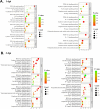Transcriptome profiles of organ tissues from pigs experimentally infected with African swine fever virus in early phase of infection
- PMID: 38847223
- PMCID: PMC11210422
- DOI: 10.1080/22221751.2024.2366406
Transcriptome profiles of organ tissues from pigs experimentally infected with African swine fever virus in early phase of infection
Abstract
African swine fever, caused by African swine fever virus (ASFV), is a highly contagious and fatal disease that poses a significant threat to the global pig industry. The limited information on ASFV pathogenesis and ASFV-host interactions has recently prompted numerous transcriptomic studies. However, most of these studies have focused on elucidating the transcriptome profiles of ASFV-infected porcine alveolar macrophages in vitro. Here, we analyzed dynamic transcriptional patterns in vivo in nine organ tissues (spleen, submandibular lymph node, mesenteric lymph node, inguinal lymph node, tonsils, lungs, liver, kidneys, and heart) obtained from pigs in the early stages of ASFV infection (1 and 3 d after viremia). We observed rapid spread of ASFV to the spleen after viremia, followed by broad transmission to the liver and lungs and subsequently, the submandibular and inguinal lymph nodes. Profound variations in gene expression patterns were observed across all organs and at all time-points, providing an understanding of the distinct defence strategies employed by each organ against ASFV infection. All ASFV-infected organs exhibited a collaborative response, activating immune-associated genes such as S100A8, thereby triggering a pro-inflammatory cytokine storm and interferon activation. Functional analysis suggested that ASFV exploits the PI3K-Akt signalling pathway to evade the host immune system. Overall, our findings provide leads into the mechanisms underlying pathogenesis and host immune responses in different organs during the early stages of infection, which can guide further explorations, aid the development of efficacious antiviral strategies against ASFV, and identify valuable candidate gene targets for vaccine development.
Keywords: African swine fever; differentially expressed gene; immune response; organ tissue tropism; transcriptome.
Conflict of interest statement
No potential conflict of interest was reported by the author(s).
Figures





Similar articles
-
Transcriptome profile of spleen tissues from locally-adapted Kenyan pigs (Sus scrofa) experimentally infected with three varying doses of a highly virulent African swine fever virus genotype IX isolate: Ken12/busia.1 (ken-1033).BMC Genomics. 2022 Jul 19;23(1):522. doi: 10.1186/s12864-022-08754-8. BMC Genomics. 2022. PMID: 35854219 Free PMC article.
-
Identification of cepharanthine as an effective inhibitor of African swine fever virus replication.Emerg Microbes Infect. 2024 Dec;13(1):2429624. doi: 10.1080/22221751.2024.2429624. Epub 2024 Dec 5. Emerg Microbes Infect. 2024. PMID: 39638605 Free PMC article.
-
African Swine Fever Virus E120R Protein Inhibits Interferon Beta Production by Interacting with IRF3 To Block Its Activation.J Virol. 2021 Aug 25;95(18):e0082421. doi: 10.1128/JVI.00824-21. Epub 2021 Aug 25. J Virol. 2021. PMID: 34190598 Free PMC article.
-
Structure of African Swine Fever Virus and Associated Molecular Mechanisms Underlying Infection and Immunosuppression: A Review.Front Immunol. 2021 Sep 6;12:715582. doi: 10.3389/fimmu.2021.715582. eCollection 2021. Front Immunol. 2021. PMID: 34552586 Free PMC article. Review.
-
Transcriptome signatures of host tissue infected with African swine fever virus reveal differential expression of associated oncogenes.Arch Virol. 2024 Feb 21;169(3):54. doi: 10.1007/s00705-023-05959-4. Arch Virol. 2024. PMID: 38381218 Review.
Cited by
-
Infection Characteristics, Transcriptomics, and Metabolomics of African Swine Fever Virus SY-1 Strain in Orally Infected Weaned Landrace Piglets.Transbound Emerg Dis. 2025 Jul 14;2025:2453420. doi: 10.1155/tbed/2453420. eCollection 2025. Transbound Emerg Dis. 2025. PMID: 40692872 Free PMC article.
References
MeSH terms
LinkOut - more resources
Full Text Sources
Other Literature Sources
